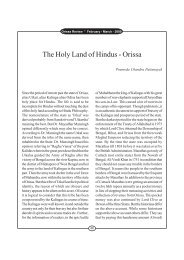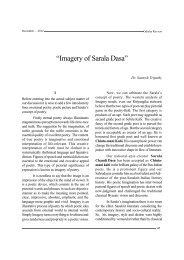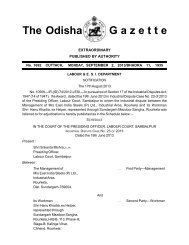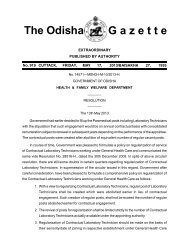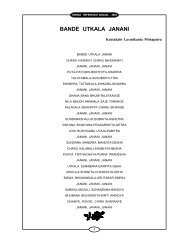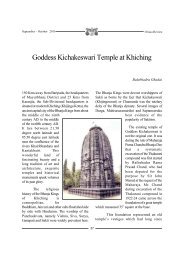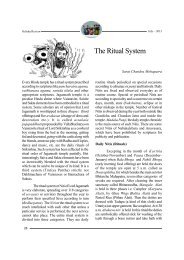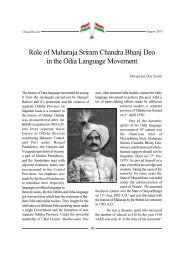Past Significance and Present Meaning in Fakir ... - Odisha.gov.in
Past Significance and Present Meaning in Fakir ... - Odisha.gov.in
Past Significance and Present Meaning in Fakir ... - Odisha.gov.in
Create successful ePaper yourself
Turn your PDF publications into a flip-book with our unique Google optimized e-Paper software.
<strong>Odisha</strong> Review January - 2013<br />
<strong>Past</strong> <strong>Significance</strong><br />
<strong>and</strong> <strong>Present</strong> <strong>Mean<strong>in</strong>g</strong> <strong>in</strong><br />
<strong>Fakir</strong> Mohan Senapati’s Rebati<br />
Dr. Shruti Das<br />
Rebati the first recorded short story <strong>in</strong> Odia<br />
literature was written by <strong>Fakir</strong> Mohan Senapati<br />
<strong>and</strong> first published <strong>in</strong> 1898 (Pattnaik 61). The<br />
story presents a microcosmic view of colonial<br />
<strong>Odisha</strong> <strong>in</strong> the late n<strong>in</strong>eteenth century, where non-<br />
Western orthodoxy <strong>and</strong> values of Western<br />
emancipation are at conflict with each other. In<br />
the story, a young adolescent girl Rebati is allowed<br />
to host aspirations of emancipation shown to her<br />
by her father, Shyamb<strong>and</strong>hu <strong>and</strong> a teacher named<br />
Basudev; both <strong>in</strong>fluenced by Western humanistic<br />
values. She is happy <strong>in</strong> the comfortable space that<br />
her family offers her education until killer epidemic,<br />
cholera strikes <strong>and</strong> everyth<strong>in</strong>g is taken away from<br />
her with the death of her parents. Rebati’s<br />
untutored m<strong>in</strong>d is unable to comprehend her<br />
predicament <strong>in</strong> the face of utter neglect, sorrow,<br />
guilt <strong>and</strong> poverty; she ultimately, succumbs to<br />
death. Today any <strong>in</strong>terpretation of this colonial<br />
text cannot be done without a contemporary<br />
Post-colonial evaluation. The <strong>in</strong>terpretation of<br />
Rebati has to come to terms with the tension<br />
between historical values <strong>and</strong> modern evaluations.<br />
This paper attempts to analyze how the colonial<br />
or past significance of the depiction of the social<br />
history <strong>in</strong> Rebati has mean<strong>in</strong>g for the modern<br />
reader <strong>in</strong> the present context. The analysis shows<br />
that the problem here is not whether or not to<br />
accept the orthodoxy of a world of non-Western<br />
culture <strong>and</strong> a different world offer<strong>in</strong>g Western<br />
humanistic rationalism as po<strong>in</strong>ts of reference, but<br />
rather how to relate them <strong>in</strong> present<strong>in</strong>g the<br />
dialectics of a new unity <strong>in</strong> a post-colonial world.<br />
N<strong>in</strong>eteenth century was a significant<br />
period <strong>in</strong> history when the British brought with<br />
them <strong>in</strong>to India the enlightenment of the West. ‘…<br />
Enlightenment humanism <strong>and</strong> its legatees take<br />
‘humanity’ to be a function of the way <strong>in</strong> which<br />
man knows th<strong>in</strong>gs. Its concern, accord<strong>in</strong>gly, is with<br />
the structure of epistemology or the basis <strong>and</strong><br />
validity of knowledge…. It changes the way <strong>in</strong><br />
which we have come to know the notion of Self’<br />
(G<strong>and</strong>hi 29). This suggested a humanist<br />
valorization of man that is accompanied by a<br />
notion that some human be<strong>in</strong>gs are more human<br />
than others may be due to their access to superior<br />
learn<strong>in</strong>g or because of their cognitive faculties. The<br />
colonizers believed that Western epistemological<br />
structure needed to be implied <strong>in</strong> order to civilize<br />
their colonies which accord<strong>in</strong>g to them were<br />
<strong>in</strong>habited by humanist subclasses. Particularly <strong>in</strong><br />
India, this historical logic is illustrated <strong>in</strong> Thomas<br />
Bab<strong>in</strong>gton Macaulay’s <strong>in</strong>famous m<strong>in</strong>ute of 1835<br />
regard<strong>in</strong>g the <strong>in</strong>troduction of English education <strong>in</strong><br />
colonial India.<br />
The <strong>in</strong>tr<strong>in</strong>sic superiority of Western<br />
literature is <strong>in</strong>deed fully admitted by those<br />
members of the committee who support the<br />
oriental plan of education. . . It is, I believe, no<br />
exaggeration to say that all the historical<br />
<strong>in</strong>formation which has been collected <strong>in</strong> the<br />
30
January - 2013<br />
Sanskrit language is less valuable than what may<br />
be found <strong>in</strong> the paltry abridgements used at<br />
preparatory schools <strong>in</strong> Engl<strong>and</strong>. (Said 1983.12).<br />
The English thought that India suffered<br />
from civilizational <strong>in</strong>feriority <strong>and</strong> Western<br />
education was the only answer to the<br />
“pathological deficiency of the native m<strong>in</strong>d”<br />
(G<strong>and</strong>hi 30).<br />
Through his narrative <strong>in</strong> Rebati the writer<br />
<strong>Fakir</strong> Mohan probably subverts this <strong>and</strong> po<strong>in</strong>ts<br />
to the actual harm that is done to the society by<br />
means of such subtle ideological coercion. Rebati<br />
a young girl of ten lives <strong>in</strong> “Patapur- a sleepy little<br />
village <strong>in</strong> Hariharpur subdivision <strong>in</strong> the district of<br />
Cuttack” (St Pierre 9). Her father belongs to the<br />
new class of Indians who had, after the<br />
implementation of Lord Macaulay’s M<strong>in</strong>utes on<br />
Indian Education <strong>in</strong> 1835, received an education<br />
<strong>in</strong> the British system. He was “the zam<strong>in</strong>dar’s<br />
accountant… responsible for collect<strong>in</strong>g taxes. His<br />
salary was two rupees a month, but he could earn<br />
a little more by adjust<strong>in</strong>g rent receipts <strong>and</strong> l<strong>and</strong><br />
records; all told, he made at least four rupees…<br />
he was quite comfortable. His family never<br />
compla<strong>in</strong>ed of want<strong>in</strong>g for anyth<strong>in</strong>g”. The family<br />
comprised Shyamb<strong>and</strong>hu, his wife, his old mother<br />
<strong>and</strong> young daughter, Rebati. Rebati the apple of<br />
everybody’s eye, was close to her father <strong>and</strong> often<br />
<strong>in</strong> the even<strong>in</strong>gs sat beside him <strong>and</strong> recited prayer<br />
songs <strong>and</strong> hymns that she had learnt orally by<br />
listen<strong>in</strong>g to him. At this po<strong>in</strong>t the narrator<br />
<strong>in</strong>troduces Basudev, a young man who has come<br />
to the village as a school teacher. Basudev, who<br />
is an orphan, ga<strong>in</strong>s the sympathy of<br />
Shyamb<strong>and</strong>hu’s family <strong>and</strong> endears himself to<br />
them. He is a regular visitor to the family <strong>and</strong> as<br />
such becomes a catalyst <strong>in</strong> further<strong>in</strong>g the narrative.<br />
He tells Shyamb<strong>and</strong>hu about a “school at Cuttack<br />
where girls could study <strong>and</strong> also learn crafts”.<br />
Shyamb<strong>and</strong>hu, <strong>in</strong>itiated <strong>in</strong> Western rationalism,<br />
immediately sees hope for his daughter: “<strong>in</strong>stantly,<br />
<strong>Odisha</strong> Review<br />
the desire to give Rebati an education welled up<br />
<strong>in</strong> his heart”. Rebati is excited at this prospect<br />
<strong>and</strong> rushes <strong>in</strong>side to her mother <strong>and</strong> gr<strong>and</strong>mother<br />
announc<strong>in</strong>g that she was go<strong>in</strong>g to study, that she<br />
was go<strong>in</strong>g to learn, to read. The mother who is a<br />
part of the new generation is agreeable to the idea<br />
of educat<strong>in</strong>g Rebati, her girl child, whereas, the<br />
gr<strong>and</strong>mother f<strong>in</strong>ds it unacceptable.<br />
The conflict <strong>in</strong> the narrative compels us<br />
to underst<strong>and</strong> the past significance, the underly<strong>in</strong>g<br />
history that ‘requires the enlistment of our<br />
sympathies <strong>and</strong> antipathies, the “basic direct<strong>in</strong>g<br />
feel<strong>in</strong>gs” which account for one’s be<strong>in</strong>g pulled<br />
along by a story’ (M<strong>in</strong>k 111). It establishes a sense<br />
of an outcome that renders the story followable.<br />
<strong>Fakir</strong> Mohan’s historical narrative <strong>in</strong> Rebati<br />
subverts a political <strong>and</strong> cultural component <strong>and</strong><br />
transfigures it <strong>in</strong>to an imag<strong>in</strong>ative universality. Here<br />
it is relevant to note that, “The features which<br />
enable a story to flow <strong>and</strong> us to follow, then, are<br />
the clues to the nature of historical underst<strong>and</strong><strong>in</strong>g.<br />
An historical narrative does not demonstrate the<br />
necessity of events but makes them <strong>in</strong>telligible by<br />
unfold<strong>in</strong>g the story which connects their<br />
significance”. In Rebati the narrative exposes the<br />
social conflict concern<strong>in</strong>g women education <strong>and</strong><br />
emancipation <strong>and</strong> problematises the reality of<br />
non- Western culture <strong>and</strong> Western rationalistic<br />
values. The gr<strong>and</strong>mother’s sharp reaction to the<br />
idea of educat<strong>in</strong>g Rebati: ‘What good will it do<br />
you ? How does book-learn<strong>in</strong>g help a girl ? It’s<br />
enough to know how to cook, bake, churn butter<br />
<strong>and</strong> decorate walls with rice-paste’ (St Pierre 13),<br />
is a po<strong>in</strong>ter to the fact that women education <strong>and</strong><br />
emancipation was very much looked down upon<br />
<strong>in</strong> those times. On the one h<strong>and</strong>, the gr<strong>and</strong>mother<br />
implores her son not to allow Rebati to study:<br />
‘Shyam, is Rebi go<strong>in</strong>g to study? Why should she<br />
study, son? What good is that for a girl ?’, <strong>and</strong> on<br />
the other, the young girl jumps with excitement.<br />
31
<strong>Odisha</strong> Review January - 2013<br />
‘Rebati was furious at her gr<strong>and</strong>mother. “You silly<br />
old fool !” she snorted. Turn<strong>in</strong>g to her father, she<br />
begged him, “Father, I do want to study.”<br />
“And so you will,’ said Shamb<strong>and</strong>hu.<br />
With the sanction of her rationalist father,<br />
<strong>and</strong> her teacher, Basudev, Rebati began her<br />
education. Much to the irritation of her<br />
gr<strong>and</strong>mother, picture books were bought for her<br />
<strong>and</strong> on the auspicious occasion of Sri Panchami,<br />
she formally began learn<strong>in</strong>g the alphabets. In two<br />
years time she had progressed a lot. Though she<br />
loved Rebati, yet, the gr<strong>and</strong>mother still harboured<br />
misgiv<strong>in</strong>gs about Rebati’s education. Instead, she<br />
is more <strong>in</strong>terested <strong>in</strong> arrang<strong>in</strong>g Rebati’s marriage<br />
with Basudev as he belongs to the same caste as<br />
theirs.<br />
The non-Western/ Odia culture to which<br />
the gr<strong>and</strong>mother belonged, naturally desired to<br />
preserve its own identity <strong>and</strong> pursue its own<br />
happ<strong>in</strong>ess. Montesquieu, who was <strong>in</strong>terested <strong>in</strong><br />
the social <strong>and</strong> political <strong>in</strong>stitutions of non-European<br />
societies rightly observed that, “all human be<strong>in</strong>gs<br />
naturally desired to preserve themselves, live <strong>in</strong><br />
society <strong>and</strong> pursue happ<strong>in</strong>ess, <strong>and</strong> loved their<br />
family. His conception of self preservation was<br />
much deeper … <strong>and</strong> <strong>in</strong>volved not just stay<strong>in</strong>g alive<br />
but absence of terror, or an oppressive <strong>and</strong><br />
pervasive sense of fear, vulnerability <strong>and</strong><br />
unpredictability…. Although reason was a most<br />
valuable capacity, it had its limits. It could never<br />
suppress or elim<strong>in</strong>ate basic human passions <strong>and</strong><br />
must come to terms with them. (Parekh 58-<br />
59).The old gr<strong>and</strong>mother loved her family very<br />
much. The <strong>in</strong>vasion of Western rationalism <strong>and</strong><br />
all that it sought to revolutionize posited a threat<br />
to the familiar environment of the old lady <strong>in</strong> the<br />
narrative. Woman emancipation was a concept<br />
unth<strong>in</strong>kable <strong>in</strong> the then Odia society which was<br />
primarily patriarchic <strong>in</strong> nature. The deep human<br />
need to cl<strong>in</strong>g on to non-rationalistic social laws is<br />
exhibited <strong>in</strong> the character of the gr<strong>and</strong>mother, who<br />
feels threatened by the pluralism of rational<br />
humanism. She would rather, her gr<strong>and</strong>-daughter<br />
Rebati mastered the skills of homemak<strong>in</strong>g <strong>and</strong> got<br />
married to a man of her parents’ choice; <strong>in</strong> this<br />
case Basudev. Although it may appear sacrilegious<br />
today, it was a practice <strong>in</strong> Odia society to marry<br />
girls off by the time they were twelve to thirteen<br />
years of age. This phenomenon bore validity <strong>in</strong>side<br />
its own limited society <strong>and</strong> carried no conviction<br />
with outsiders from a more rationalistic world. The<br />
narrator uses gentle irony to underl<strong>in</strong>e this. He<br />
says: “What Rebati made of all this she alone<br />
knew, but a change certa<strong>in</strong>ly came over her” (St<br />
Pierre 15). The contradiction here<strong>in</strong> is that, Rebati<br />
ab<strong>and</strong>ons all her dreams of education <strong>and</strong><br />
emancipation <strong>and</strong> will<strong>in</strong>gly falls prey to an<br />
irrational prevalent system that she herself does<br />
not underst<strong>and</strong>.<br />
The narrative subverts reality <strong>and</strong> offers<br />
a critique of the morality of the text. It questions<br />
the genesis of the work <strong>and</strong> its relevant evaluation.<br />
“… To make this po<strong>in</strong>t from a somewhat different<br />
angle, one might refer to two basic functions of<br />
literature: on the one h<strong>and</strong> the work of art as a<br />
product of its time, a mirror of its age, a historical<br />
reflection of the society to which both the author<br />
<strong>and</strong> the orig<strong>in</strong>al audience belonged. On the other<br />
h<strong>and</strong>, it is surely no idealism to assume that the<br />
work of art is not merely a product, but a<br />
“producer” of its age: not merely a mirror of the<br />
past, but a lamp to the future” (Weimann 55-<br />
56).The narrative exposes the reader to the<br />
devastation, both social <strong>and</strong> economic, brought<br />
about by the killer p<strong>and</strong>emic cholera. Death tolls<br />
<strong>in</strong> India itself <strong>in</strong> the n<strong>in</strong>eteenth century due to<br />
cholera outbreaks were enormous. Accord<strong>in</strong>g to<br />
the data given <strong>in</strong> the Wikipedia ‘deaths <strong>in</strong> India<br />
between 1817 <strong>and</strong> 1860 are estimated to have<br />
exceeded fifteen million people. Another twentythree<br />
million died between 1865 <strong>and</strong> 1917’<br />
(Wikipedia.org/wiki/cholera). The people of the<br />
period could not comprehend the enormity of the<br />
tragedy <strong>and</strong> <strong>in</strong> their own simple ways sought to<br />
f<strong>in</strong>d some means of underst<strong>and</strong><strong>in</strong>g the unstoppable<br />
32
January - 2013<br />
deaths. S<strong>in</strong>ce no possible reason or solution was<br />
available to them they found a scapegoat <strong>in</strong> the<br />
unnatural: ‘the demonic deity’. <strong>Fakir</strong> Mohan with<br />
delicate irony reproduces a situation familiar to<br />
rural colonial India, abjectly poor <strong>and</strong> uncared<br />
for. He presupposes the impact of the text on the<br />
reader. He calls upon the aesthetic perception of<br />
the post-colonial reader to underst<strong>and</strong> the social<br />
<strong>and</strong> economic devastation caused by such<br />
calamities <strong>and</strong> the exploitation of the victims<br />
thereafter.<br />
One f<strong>in</strong>e Phalgun day, like a bolt out of<br />
the blue, a cholera epidemic struck.<br />
Early <strong>in</strong> the morn<strong>in</strong>g the news of<br />
Shyamb<strong>and</strong>hu com<strong>in</strong>g down with cholera spread<br />
through the village. As always, the immediate<br />
response was to bolt the doors <strong>and</strong> w<strong>in</strong>dows <strong>and</strong><br />
keep out of the path of the demonic deity, as<br />
though the evil old hag was out with her basket<br />
<strong>and</strong> brooms sweep<strong>in</strong>g up heads.<br />
Shyamb<strong>and</strong>hu’s wife <strong>and</strong> mother were<br />
soon driven out of their m<strong>in</strong>ds by worry <strong>and</strong><br />
anxiety. Rebati ran <strong>in</strong> <strong>and</strong> out of the house, cry<strong>in</strong>g<br />
for help… help was neither expected nor<br />
forthcom<strong>in</strong>g (St Pierre 16-17).<br />
Instead of be<strong>in</strong>g sympathetic, neighbours<br />
<strong>and</strong> people of the community rejected the family<br />
<strong>and</strong> treated them as pariahs. The epidemic<br />
generated fear of such dimension that people<br />
became almost paranoid. Instead of help<strong>in</strong>g their<br />
brethren they deserted even their own kith <strong>and</strong><br />
k<strong>in</strong> bolt<strong>in</strong>g doors <strong>and</strong> w<strong>in</strong>dows to ‘keep out of<br />
the path of the demonic deity. People conceived<br />
of cholera as an evil old woman who was out<br />
with her basket <strong>and</strong> broom to sweep up heads.<br />
There was no awareness or education<br />
propagated about the disease to prove to the<br />
people that they were wrong.<br />
The <strong>in</strong>fection spread <strong>in</strong> the family like<br />
quick fire <strong>and</strong> affected Rebati’s mother. ‘By<br />
midday the news of her death was all over the<br />
<strong>Odisha</strong> Review<br />
village’. Rebati’s family was completely isolated;<br />
no help was forthcom<strong>in</strong>g nor expected. The only<br />
loyal friend of the family was Basudev, the school<br />
teacher. Rebati offers a microcosmic view of<br />
colonial India where exploitation was the<br />
keyword. After the epidemic, the isolated family<br />
was left with an old lady, a young girl, a few cows<br />
<strong>and</strong> the l<strong>and</strong> that Shyamb<strong>and</strong>hu had possessed.<br />
‘With<strong>in</strong> three months of Shyamb<strong>and</strong>hu’s demise<br />
the zam<strong>in</strong>dar expropriated Shyamb<strong>and</strong>hu’s cowsapparently<br />
he had not deposited the last tax<br />
collection'. <strong>Fakir</strong> Mohan throughout the narrative<br />
has ma<strong>in</strong>ta<strong>in</strong>ed that Shyamb<strong>and</strong>hu was an honest<br />
man <strong>and</strong> ‘had always regarded deposit<strong>in</strong>g the<br />
money as sacred <strong>and</strong> would not rest <strong>in</strong> peace until<br />
every paise of the collection was <strong>in</strong> the zam<strong>in</strong>dar’s<br />
treasury.' The zam<strong>in</strong>dars were next <strong>in</strong> the hierarchy<br />
after the British colonial masters. It was through<br />
their agency that exploitation filtered down to the<br />
lowest rung of society. Appeal<strong>in</strong>g to the anticolonial<br />
modern sensibility, the narrator says: ‘The<br />
truth was that for a long time the zam<strong>in</strong>dar had<br />
had his eyes on the cows. He also took back the<br />
three <strong>and</strong> half acres he had given to<br />
Shyamb<strong>and</strong>hu’. The pathetic plight of the affected<br />
family is further enunciated as remnants of pride<br />
are visible through abject penury under economic<br />
devastation:<br />
The team of bullocks had already been<br />
sold off for seventeen <strong>and</strong> half rupees; with what<br />
rema<strong>in</strong>ed of the sum after the funeral expenses,<br />
the gr<strong>and</strong>mother <strong>and</strong> Rebati hung on for a month.<br />
In the month follow<strong>in</strong>g they had begun to pawn<br />
household items – a brass bowl one day, a plate<br />
the next.<br />
Basu visited them every even<strong>in</strong>g <strong>and</strong><br />
stayed with them till bedtime. He offered them<br />
money, but they would not touch it. Once or twice<br />
he pressed some on them, but the co<strong>in</strong>s lay idle<br />
on the shelf. He had no choice but to accept the<br />
couple of paise the old woman produced every<br />
eight or ten days to buy them provisions. The<br />
33
<strong>Odisha</strong> Review January - 2013<br />
house was fall<strong>in</strong>g apart, the straw roof was worn<br />
th<strong>in</strong>, but try as he might Basu couldn’t get it rethatched;<br />
the bales of hay he bought with two<br />
rupees of his own money rotted <strong>in</strong> the backyard.<br />
Basudev had promised Rebati’s father on<br />
his death bed that he would look after the family.<br />
But the pathetic pride exhibited by the<br />
gr<strong>and</strong>mother evokes an imag<strong>in</strong>ative universality.<br />
The reader is given to underst<strong>and</strong> that after the<br />
death of Shyamb<strong>and</strong>hu Basudev would take on<br />
the responsibilities of the family, perhaps even<br />
marry Rebati. But noth<strong>in</strong>g like this happens; the<br />
narrator parodies the reader’s expectation <strong>and</strong><br />
purposely evokes certa<strong>in</strong> responses <strong>in</strong> the<br />
beg<strong>in</strong>n<strong>in</strong>g of the story only to frustrate them later<br />
on. “This can serve not only a critical purpose<br />
but can even have a poetic effect” (Jauss 17).<br />
The reality of the story po<strong>in</strong>ts out that the truth of<br />
life cont<strong>in</strong>ually denies the lies of poetic fiction.<br />
The gr<strong>and</strong>mother, the only liv<strong>in</strong>g relative<br />
of Rebati, <strong>in</strong>stead of pil<strong>in</strong>g her love on the child <strong>in</strong><br />
her moment of crisis vents her frustration on the<br />
child. She becomes a typical case of Passive-<br />
Aggressive (negativistic) Personality Disorder.<br />
Accord<strong>in</strong>g to Ekleberry <strong>in</strong> The Dual Diagnosis<br />
Pages, <strong>in</strong>dividuals with passive-aggressive<br />
(negativistic) personality disorder are ambivalent<br />
with<strong>in</strong> their relationships <strong>and</strong> conflicted between<br />
their dependency needs <strong>and</strong> their desire for selfassertion.<br />
They express hostility towards the<br />
people they see as caus<strong>in</strong>g their problems. ‘These<br />
<strong>in</strong>dividuals are noted for the stormy nature of their<br />
<strong>in</strong>terpersonal relationships…. They are resentfully<br />
quarrelsome <strong>and</strong> irritable. They often feel like a<br />
victim. Central to the disorder is a pervasive<br />
pattern of argumentativeness <strong>and</strong> oppositional<br />
behaviour with defeatist <strong>and</strong> negative attitudes…<br />
These <strong>in</strong>dividuals <strong>in</strong>flict a great deal of discomfort<br />
on others through the use of their anxiety <strong>and</strong><br />
emotional symptoms…. They engage <strong>in</strong><br />
grumbl<strong>in</strong>g, moody compla<strong>in</strong>ts, <strong>and</strong> sour<br />
pessimism; these behaviours serve as both a<br />
vehicle for tension discharge… <strong>and</strong> as a means<br />
of <strong>in</strong>timidat<strong>in</strong>g others <strong>and</strong> <strong>in</strong>duc<strong>in</strong>g guilt. After<br />
death of her son Shyamb<strong>and</strong>hu <strong>and</strong> his wife; <strong>and</strong><br />
the action of the zam<strong>in</strong>dar, the small world of the<br />
gr<strong>and</strong>mother crumbles. Buckl<strong>in</strong>g under grief,<br />
poverty <strong>and</strong> frustration she f<strong>in</strong>ds a scapegoat <strong>in</strong><br />
her gr<strong>and</strong>-daughter Rebati. ‘The old woman’s<br />
vision had decl<strong>in</strong>ed <strong>and</strong> she had a wild look about<br />
her. She no longer cried as much <strong>and</strong> took to<br />
heap<strong>in</strong>g curses <strong>and</strong> abuse on Rebati: the wretched<br />
girl was at the root of all her misery <strong>and</strong> misfortune;<br />
her education had caused it all – first her son had<br />
died, then her daughter-<strong>in</strong>-law; the bullocks had<br />
been sold off; the farm h<strong>and</strong> had left; the cows<br />
had been taken back by the zam<strong>in</strong>dar; <strong>and</strong> now<br />
her eyes had gone bad. Rebati was the evil-eye,<br />
the hell-devil, the ill omen’(St Pierre 18-19). The<br />
gr<strong>and</strong>mother’s anxiety <strong>and</strong> frustration found<br />
release <strong>in</strong> abus<strong>in</strong>g Rebati. Rebati’s education was<br />
not the convention of the times, girls were only to<br />
be taught kitchen craft <strong>and</strong> how to take care of<br />
their family with subservience; anyth<strong>in</strong>g otherwise<br />
especially, Western education was looked upon<br />
with suspicion <strong>and</strong> therefore she blamed Rebati’s<br />
education for the misfortune that had befallen her<br />
family. Often irritable she would call out to Rebati<br />
“Rebati! Rebi! You fire! You ashes!”(9/ 27).<br />
The gr<strong>and</strong>mother is a construct of<br />
patriarchic society. The ironic voice of the narrator<br />
tries to represent the “nationalist trepidation about<br />
the ‘Westernisation’ of Indian women”(G<strong>and</strong>hi 96)<br />
through her. <strong>Fakir</strong> Mohan’s sensitive portrayal of<br />
Rebati br<strong>in</strong>gs to focus the conflict between socalled<br />
cultural authenticity <strong>and</strong> Western<br />
emancipatory education of the Indian woman.<br />
Leela G<strong>and</strong>hi <strong>in</strong> her book, Post Colonial Theory:<br />
A Critical Introduction, observes the extent to<br />
which the nation authenticates its dist<strong>in</strong>ct cultural<br />
identity through its women. She talks of Partha<br />
Chatterjee’s work on anti-colonial nationalism:<br />
…draw<strong>in</strong>g attention to the subtle nuances of the<br />
nationalist compromise with the <strong>in</strong>vasive<br />
34
January - 2013<br />
hegemony of colonial/Western values. Indian<br />
nationalists… dealt with the compulsive claims of<br />
Western civilization by divid<strong>in</strong>g the doma<strong>in</strong> of<br />
culture <strong>in</strong>to two dist<strong>in</strong>ct spheres- the material <strong>and</strong><br />
the spiritual. It was hard to contest the superiority<br />
<strong>and</strong> dom<strong>in</strong>ation of the West <strong>in</strong> the material sphere.<br />
But on the other h<strong>and</strong>, as texts like G<strong>and</strong>hi’s H<strong>in</strong>d<br />
Swaraj proclaimed, no cultural rival could<br />
possibly match India’s spiritual essence. Thus,<br />
as Chatterjee writes, while it was deemed<br />
necessary to cultivate <strong>and</strong> imitate the material<br />
accomplishments of Western civilization, it was<br />
compulsory to simultaneously preserve <strong>and</strong> police<br />
the spiritual properties of national culture. And <strong>in</strong><br />
the catalogue of the nation’s spiritual effects, the<br />
home <strong>and</strong> its keeper acquired a troublesome preem<strong>in</strong>ence….<br />
'The home <strong>in</strong> its essence must rema<strong>in</strong><br />
unaffected by the profane activities of the material<br />
world- <strong>and</strong> woman is its representation.'<br />
As an anti-colonial critique the narrative<br />
necessitates that the gr<strong>and</strong>mother <strong>in</strong> Rebati<br />
becomes the police <strong>and</strong> the preserver of the<br />
spiritual essence of national culture, represent<strong>in</strong>g<br />
the nationalist possessiveness about ‘native<br />
women’. She tries to guard her gr<strong>and</strong> daughter<br />
Rebati from the <strong>in</strong>vasion of foreign values <strong>in</strong> the<br />
form of education, which is supposedly demonic<br />
<strong>and</strong> possibly out to destroy the spiritual essence<br />
alias cultural identity of the nation. Hence, though<br />
unreasonable, she blames Rebati, Basudev <strong>and</strong><br />
formal education for all that has happened to her<br />
family. Education a ‘profane activity’ of the<br />
material world should not have been nurtured.<br />
Rebati, the girl child, the representative of the<br />
future of the nation, the carrier of the cultural<br />
identity should not have been enthusiastic about<br />
education. Now that she had been, it was her<br />
turn for retribution : her suffer<strong>in</strong>g <strong>and</strong> the abuse<br />
that she was subjected to was apparently justified.<br />
The gr<strong>and</strong>mother tartly comments: “What<br />
medic<strong>in</strong>e can there be for an illness of one’s own<br />
mak<strong>in</strong>g!’ Rebati had brought the fever on herself<br />
by dar<strong>in</strong>g to study” (St Pierre 23).<br />
<strong>Odisha</strong> Review<br />
Rebati whose vibrant presence <strong>in</strong>vaded<br />
the first part of the story recedes to the marg<strong>in</strong>s <strong>in</strong><br />
the second half. She could be termed as a<br />
‘gendered subaltern’. In her essay “Can the<br />
subaltern speak?” Spivak elaborates on contest<strong>in</strong>g<br />
representational systems, here anti-colonial<br />
patriarchy, that violently displaces or silences the<br />
‘gendered subaltern’. She writes:<br />
Between patriarchy <strong>and</strong> imperialism,<br />
subject-constitution <strong>and</strong> object-formation, the<br />
figure of the woman disappears, not <strong>in</strong>to a prist<strong>in</strong>e<br />
noth<strong>in</strong>gness, but a violent shuttl<strong>in</strong>g which is the<br />
displaced figuration of the ‘third-world woman’<br />
caught between tradition <strong>and</strong> modernisation.<br />
(1988. p. 306).<br />
Her essay argues that the ‘gendered<br />
subaltern’ disappears because we never hear her<br />
speak about herself. She is simply the medium<br />
through which compet<strong>in</strong>g discourses represent<br />
their claims. Rebati, the ‘gendered subaltern’ <strong>in</strong><br />
context, is forced to become a ‘third-world<br />
woman’ caught <strong>in</strong> the teeth of patriarchy <strong>and</strong><br />
imperialism. <strong>Fakir</strong> Mohan’s social critique <strong>in</strong> the<br />
narrative posits Rebati as caught between<br />
modernization <strong>and</strong> a tradition that grudges her<br />
aspirations <strong>and</strong> holds her responsible for defeat<strong>in</strong>g<br />
her spiritual duties as an Indian woman. The vibrant<br />
girl who was once not afraid to voice her desire<br />
for education:”Father, I do want to study”(St<br />
Pierre 14); is suddenly muted. As a ‘gendered<br />
subaltern’ she literally disappears from centrestage<br />
<strong>and</strong> is relegated to the marg<strong>in</strong>s of her little<br />
world. She is violently shuttled between nature<br />
<strong>and</strong> culture <strong>and</strong> assumes the displaced figure of<br />
the silent ‘third-world woman’. Accused <strong>and</strong><br />
blamed for th<strong>in</strong>gs beyond human control, Rebati<br />
shr<strong>in</strong>ks away from life itself. ’Rebati’s presence<br />
no longer filled the house; gone were the days<br />
when she would be heard mourn<strong>in</strong>g loudly.<br />
Nobody heard her voice, nobody saw her out<br />
of doors. Her large brood<strong>in</strong>g eyes, awash with<br />
silent tears, looked like blue lilies set <strong>in</strong> water.<br />
35
<strong>Odisha</strong> Review January - 2013<br />
Her heart <strong>and</strong> m<strong>in</strong>d broken, day <strong>and</strong> night were<br />
alike to her. The sun brought her no light, the night<br />
no darkness; the world was an ach<strong>in</strong>g void.<br />
Rebati is not allowed to disappear <strong>in</strong>to ‘prist<strong>in</strong>e<br />
noth<strong>in</strong>gness’ <strong>in</strong>stead lives <strong>in</strong> ‘an ach<strong>in</strong>g void’ as a<br />
victim of ‘compet<strong>in</strong>g discourses’ of the time till it<br />
f<strong>in</strong>ally kills her. The compet<strong>in</strong>g discourses <strong>in</strong> this<br />
historical context refer to Western humanistic<br />
rationalism <strong>and</strong> a non-Western Odia culture with<br />
its <strong>in</strong>herent orthodoxy. Rebati’s death is def<strong>in</strong>itely<br />
tragic; but the significance of what it expresses <strong>in</strong><br />
plot <strong>and</strong> character, <strong>in</strong> its mimetic <strong>and</strong> expressive<br />
dimensions has an affective <strong>and</strong> moral effect on<br />
the modern reader.<br />
Rebati with its rich historical significance<br />
moves along a timel<strong>in</strong>e <strong>and</strong> acquires contemporary<br />
mean<strong>in</strong>g. <strong>Fakir</strong> Mohan like Shakespeare was<br />
representative of his age, that is, n<strong>in</strong>eteenth century<br />
<strong>Odisha</strong>. It is therefore, relevant here to recall<br />
Weimann’s analysis of Shakespeare’s relevance<br />
<strong>in</strong> the contemporary times. He says, ‘that<br />
Shakespeare is “for all time” precisely because<br />
he was the “Soule of the Age.” In this view, a<br />
historical vision can be made to yield a<br />
contemporary mean<strong>in</strong>g. Its past significance was<br />
achieved because, at the time, it was<br />
contemporary <strong>and</strong> then <strong>in</strong>corporated the<br />
experience of the present. The mean<strong>in</strong>g of literary<br />
histoy can best be discovered through this past<br />
present, or that part of it which – although pastis<br />
still present <strong>and</strong> mean<strong>in</strong>gful <strong>in</strong> a contemporary<br />
frame of reference. Thus, past significance <strong>and</strong><br />
present mean<strong>in</strong>g engage <strong>in</strong> a relationship which,<br />
<strong>in</strong> its <strong>in</strong>terdependence, may illum<strong>in</strong>ate either- the<br />
past work as aga<strong>in</strong>st its present reception, <strong>and</strong><br />
the contemporary <strong>in</strong>terpretation aga<strong>in</strong>st the<br />
historical significance of the work of art. <strong>Fakir</strong><br />
Mohan can be <strong>in</strong>terpreted <strong>in</strong> the same light as his<br />
narratives which are subversively anti-colonial,<br />
engage <strong>in</strong> a mean<strong>in</strong>gful relationship with the<br />
contemporary world. The imag<strong>in</strong>ative universality<br />
of <strong>Fakir</strong> Mohan’s narrative <strong>in</strong> Rebati fuses the<br />
past <strong>and</strong> the future, the real <strong>and</strong> the aesthetic <strong>in</strong>to<br />
a timeless oneness.<br />
Works Cited :<br />
Cholera outbreaks <strong>and</strong> p<strong>and</strong>emics. From Wikipedia,<br />
the free encyclopedia. http://en.wikipedia.org/wiki/<br />
Cholera_outbreaks_<strong>and</strong>_p<strong>and</strong>emics<br />
Ekleberry, Sharon C. , Talk:Passive-aggressive<br />
behavior/S<strong>and</strong>box. From Wikipedia, the free<br />
encyclopedia Created to hold unformatted data from<br />
article. - Dreadlocke 23:48, 4 June 2006(UTC). http://<br />
en.wikipedia.org/wiki/Talk%3APassiveaggressive_behavior/S<strong>and</strong>box<br />
G<strong>and</strong>hi, Leela. Postcolonial Theory : A Critical<br />
Introduction. New Delhi: Oxford University Press, 1998.<br />
Rpt. 2007.<br />
Jauss, Hans Robert. ‘Literary History as a Challenge to<br />
Literary Theory’, <strong>in</strong> New Directions <strong>in</strong> Literary History.<br />
Ed. Ralph Cohen. London: Routledge <strong>and</strong> Kegan Paul,<br />
1974.<br />
M<strong>in</strong>k, Lois O., ‘History <strong>and</strong> Fiction as Modes of<br />
Comprehension’ <strong>in</strong> New Directions <strong>in</strong> Literary History.<br />
Ed. Ralph Cohen. London: Routledge <strong>and</strong> Kegan Paul,<br />
1974.<br />
Patnaik, J.N. ‘Life <strong>and</strong> Times of <strong>Fakir</strong> Mohan Senapati’<br />
Orissa Review. Feb-March, 2008. 61.<br />
Said, Edward W. The World, the Text <strong>and</strong> the Critic.<br />
Cambridge MA: Harvard University Press, 1983.<br />
Senapati, <strong>Fakir</strong> Mohan. ‘Rebati’. trans. Paul St-Pierre.<br />
<strong>Fakir</strong> Mohan Senapati Stories.Bhubaneswar:<br />
Grassroots, 2003.<br />
Spivak, Gayatri C. “Can the Subaltern Speak?” <strong>in</strong><br />
Marxism <strong>and</strong> Interpretation of Culture. Ed. Cary<br />
Nelson <strong>and</strong> Lawrence Grossberg. Urbana <strong>and</strong> Chicago:<br />
University of Ill<strong>in</strong>ois Press, 1988.<br />
Weimann, Robert. ‘<strong>Past</strong> <strong>Significance</strong> <strong>and</strong> <strong>Present</strong><br />
<strong>Mean<strong>in</strong>g</strong> <strong>in</strong> Literary History’ <strong>in</strong> New Directions <strong>in</strong><br />
Literary History. Ed. Ralph Cohen. London: Routledge<br />
<strong>and</strong> Kegan Paul, 1974.<br />
Dr. Shruti Das, Udayashree, Narayan Mishra Lane,<br />
Mahatab Road, Cuttack-12.<br />
36




